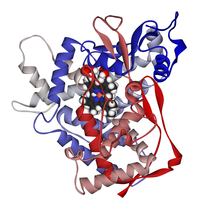
Photo from wikipedia
Methysticin is one of the naturally occurring bioactive constituents extracted from Piper methysticum Forst. In the present study, we intended to investigate the inhibitory effect of methysticin on cytochrome P450… Click to show full abstract
Methysticin is one of the naturally occurring bioactive constituents extracted from Piper methysticum Forst. In the present study, we intended to investigate the inhibitory effect of methysticin on cytochrome P450 (P450) enzymes. Methysticin exhibited time-, concentration-, and NADPH-dependent inhibition on CYP2C9 using diclofenac as a probe substrate. Approximately 85% of CYP2C9 activity was inhibited by methysticin at 50 μM after a 30 min preincubation with human liver microsomes in the presence of NADPH. The kinetic parameters KI, kinact, and t1/2,inact were 13.32 ± 1.35 μM, 0.054 ± 0.005 min-1, and 12.83 ± 3.23 min, respectively. Sulfaphenazole (competitive inhibitor of CYP2C9) displayed a significant protective effect on methysticin-induced CYP2C9 inactivation. However, the inclusion of catalase/superoxide dismutase or glutathione (GSH) showed no such protection. A carbene intermediate was postulated to be involved in methysticin-induced CYP2C9 inactivation as K3Fe(CN)6 recovered 14.96% of CYP2C9 activity. A methysticin-derived ortho-quinone intermediate dependent on NADPH was trapped by GSH, and this intermediate was believed to be involved in CYP2C9 inactivation. CYP1A2, 2C9, and 3A4 were the major enzymes responsible for methysticin bioactivation. Taken together, the present work demonstrated that methysticin was a mechanism-based inactivator of CYP2C9. Both ortho-quinone and carbene intermediates appeared to be involved in the inactivation of CYP2C9 induced by methysticin.
Journal Title: Chemical research in toxicology
Year Published: 2022
Link to full text (if available)
Share on Social Media: Sign Up to like & get
recommendations!